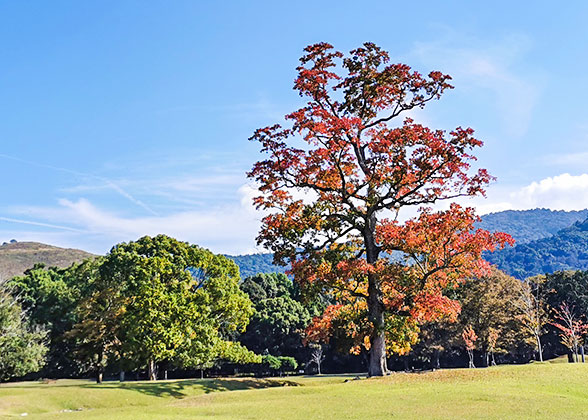Japan Weather
- Climatic Zone(s): Temperate zone, subtropical zone, sub-frigid zone
-
Climatic Features: most places are in the temperate monsoon climate, deeply influenced by the ocean with much rainfall

- Hottest Month: August
- Coldest Month: January
-
How is the weather in Japan?
With a large latitude span, Japan has complex climate. The northernmost region is in the sub-frigid zone, severely cold in winter with large amount of snowfall. The central Japan, the vast majority of places in the country, usually embraces four distractive seasons, torrid in summer and cold in winter. Besides, it’s always warm in southern island areas. The coast facing Japan Sea (northwest side) has more precipitation in winter with the monsoon from Siberia; separated by the mountain range in the central region, the eastern coast receives more rainfall in summer, with the southeast monsoon from the Pacific Ocean. - Best Time to Visit: March to early May & October to early December If you have decided to visit Japan in 2025, then you may like our Japan Tours 2025 & 2026 with Private & Group Packages.
Japan Seasons - Temperature & Clothing Guide
-
SpringMarch - May
Temperature:
6 - 14℃ (42.8 - 57.2℉)
Clothes to Wear:
thin sweater, knitwear, jacket, hoodie -
SummerJune - August
Temperature:
20 - 30℃ (68 - 86℉)
Clothes to Wear:
shirt, dress, T-shirt, light pants, sandals -
AutumnSeptember - November
Temperature:
19 - 27℃ (66.2 - 80.6℉)
Clothes to Wear:
long shirt, blouse, casual pants, sneakers
-
WinterDecember - February
Temperature:
5 - 12℃ (41 - 53.6℉)
Clothes to Wear:
sweater, thick overcoat, padded trousers
Monthly Weather of Japan - Temperature & Rainfall
oC
oF



Typhoon Season in Japan
In East Asia, Japan sees its typhoon season from June to October generally, with September to early October being the peak months. The entire Japan would encounter 20-30 typhoons every year, which bring plenty of rain and gale to the landing areas.
The rainy season will last for one month or one and a half months in Japan, generally from May to July. Rainy season begins in southern islands of Japan in early May or mid-May; the farther north you go, the later the rainy season comes. To the northeast of Honshu, rainy season comes in the early or middle June. As for Hokkaido, it is relatively an exception in Japan with no rainy season.
Cherry blossoms are blooming in the southern regions first. The farther south, the earlier the cherry blossom season. In the south of Kyushu, cherry trees put forth the blossoms in late March; to south of Hokkaido and the northernmost of Honshu, it begins until late April.
 See Also: Japan Cherry Blossom Date Forecast 2025
See Also: Japan Cherry Blossom Date Forecast 2025
Regional Weather of Japan
North Japan
- Major Destinations: Hokkaido & Aomori, Akita, etc. in the north of Tohoku (northeast Honshu)
- Weather Review: It is cooler in the northern region of Japan, especially in Hokkaido. In winter, it becomes bitterly cold with heavy snows, and it’s also somewhat cooler in summer to avoid the heat.
- Travel Recommendation: For the cooler weather, the north is the best place to enjoy the beauty of winter. Snow landscapes, ice sculptures, snow festivals, winter sports such as skiing, traditional onsen baths, etc. are all fascinating.

|
Central Japan
- Major Destinations: Tokyo, Osaka, Kyoto, Nara, and more areas in Honshu
- Weather Review: The central Japan is torrid in summer and cold in winter, with pleasant spring and autumn. The region will be caught by typhoons and the rainy season.
- Travel Recommendation: Cherry blossoms in spring and fall foliage in autumn are well-known for visitors to Japan. Historical sites like the Osaka Castle, onsen bathing in Hakone, modern cityscapes, and grand locally seasonal festivals like Gion Matsuri in Kyoto, are all visit-worthy.
South Japan

Sunset over Kamakura
|
- Major Destinations: Okinawa islands; Fukuoka, Kagoshima, etc. in Kyushu; Shikoku
- Weather Review: It is warmer in the south of Japan than other regions, with high humidity. Generally, it’s mild and humid all year around. In the transition areas of the southernmost of Honshu and the northern Kyushu, it would be a little cooler in winter.
- Travel Recommendation: The subtropical coasts and dotted islands are best for tourists to enjoy beach fun as well as island safari. Fresh seafood and local specialties can also be enjoyed on your holiday.
3-Day Weather Forecast of Major Destinations
Tokyo
Osaka
Nagoya
Sapporo
Hiroshima
Fukuoka
